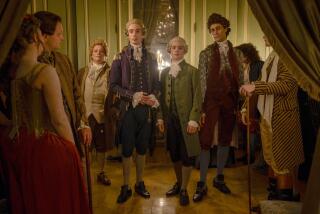Fit to Be Tied : The Superiority of the Bow
- Share via
The maddening thing about wearing a bow tieis not that you must learn to tie it. It is having to answer what bow-tie wearers the world over know as The Two Questions:
“Is that a clip-on?”
“Why do you wear a bow tie?”
The first question is beneath the dignity of the serious bow-tie connoisseur. The second is reasonable enough. Any man with a bow tie under his chin becomes an object of curiosity in a room full of four-in-hands (which is the proper name for the long tie).
Why wear something that is so uncommon? According to the Neckwear Assn. of America, $800 million a year is spent on ties in this country, but only 3% of that amount is laid out for bow ties.
Why look like a nonconformist in a world where conformity is often the key to success? According to NBC Nightly News, a recent study found that people don’t trust men who wear bow ties and that lawyers don’t like to put bow-tie wearers on juries because they are stubborn and won’t change their minds. Each bow-tie zealot has his answer, and you will get mine in a few moments. But first, some disturbing news--well, disturbing to us nonconformists: Bow ties are enjoying a resurgence.
“No doubt about it, there’s a bow-tie renaissance,” says John Fields, a former vice president of the University of Southern California who now runs a mail-order bow-tie company out of his house in Kenwood, Calif. “When you see Neiman-Marcus with bow ties in their newspaper ads, you know something is happening.”
Fields’ business, started two years ago, has succeeded “beyond all my expectations.” More than half of his clients are in the New England states and many are doctors. Fields does not know why doctors favor bow ties. He is also picking up new clients among the Yuppies--the young, upwardly mobile professionals.
Later this year book packager Helene Siegel of West Hollywood will bring out a gift packet that includes a bow tie and a booklet that provides tying instructions and some history.
About that history: Most fashion experts agree that the French got the idea for neckwear from Croatian mercenaries marching through Paris in 1660. The four-in-hand and the bow tie evolved, and the English especially liked the latter. Churchill wore bow ties. And they are still favored by some members of Parliament.
A few American politicians also favor them, but don’t look for bow ties in corporate board rooms. Asked to name executives who wear bow ties, Fields knew of only one: Robert O. Anderson, former chairman of the board of Arco. No surprise there. Robert O. Anderson started out in the oil business as a fierce independent, and he has been doing things his way ever since.
Actually, Fields did not need to tell me about Anderson. I had spotted Anderson’s polka-dot bow tie when his photograph ran with an article about his impending retirement. Like most bow-tie wearers, I have a secret ritual. I scan newspapers, magazines, television programs and books for photographs of men in bow ties. “Another nonconformist!” I shout when I find one.
Didn’t Charles Osgood have on a bow tie the other night on CBS News? Why, there’s a photo of Lyndon B. Johnson as a young congressman in the 1930s--in a Stetson and a bow tie. And isn’t George F. Will wearing a bow tie in those ads for Newsweek?
“I started wearing bow ties in the 1960s, when regular ties got fat and ugly--like politics and music and everything else,” Will said in an interview. “Bow ties looked civilized.”
What does a bow tie say about the man? “It says you know how to tie it,” Will said, “which sets you apart from the general masses of men. It also says you’re independent.”
So why do I wear bow ties? Because it gives me the greatest pleasure to get up in the morning and put one on. Bow-tie wearers know what I mean.






